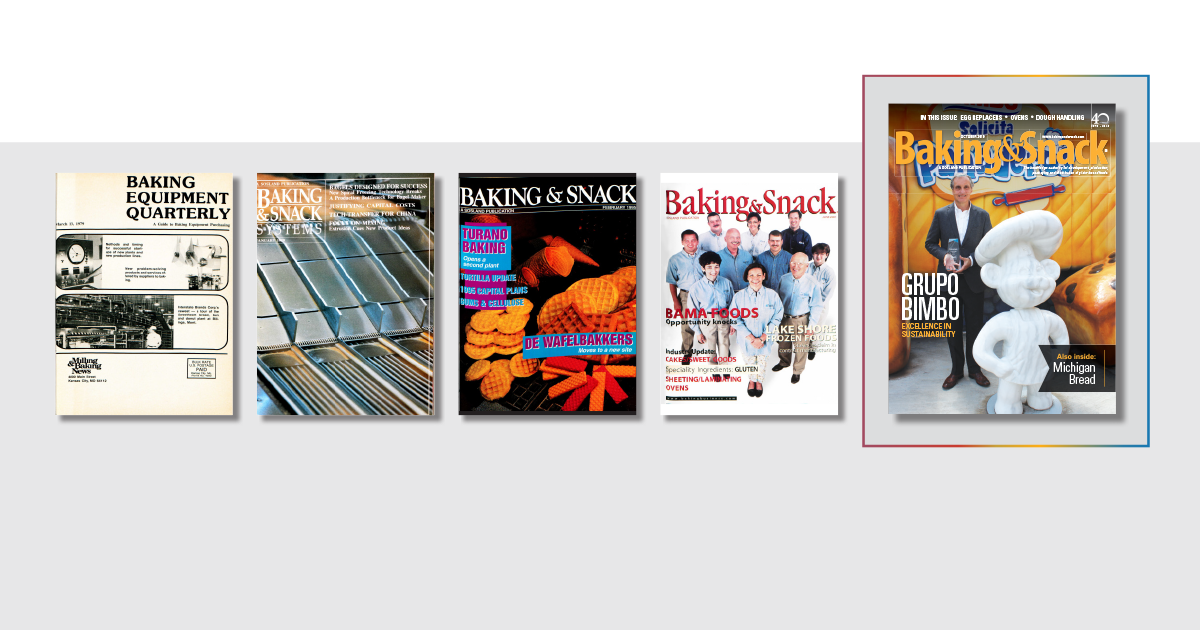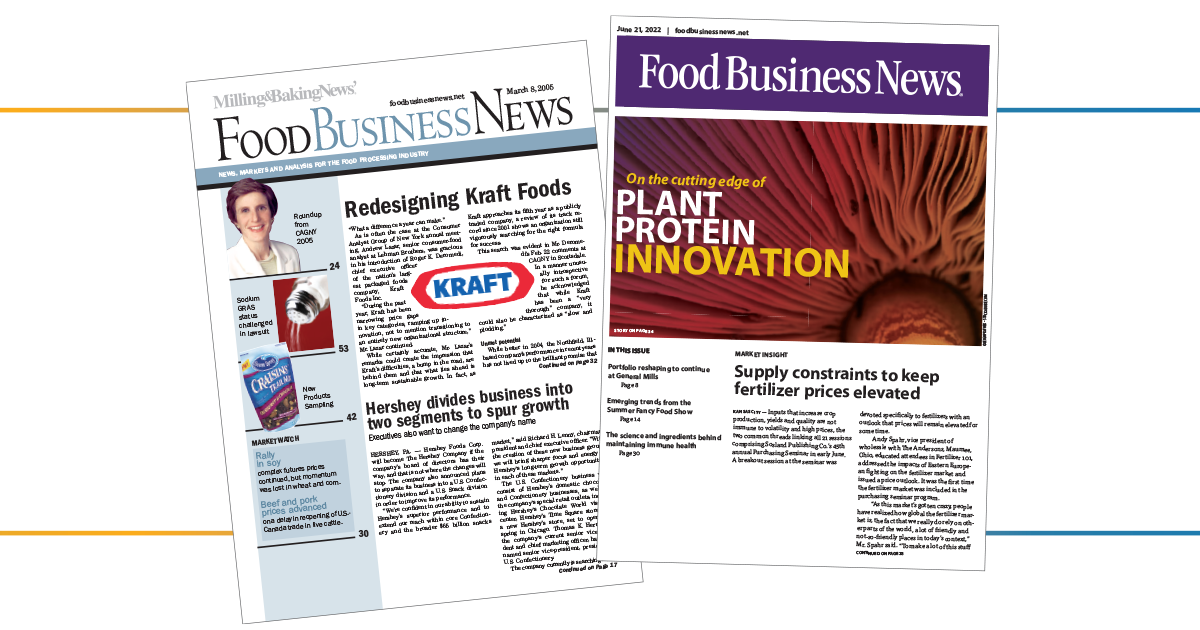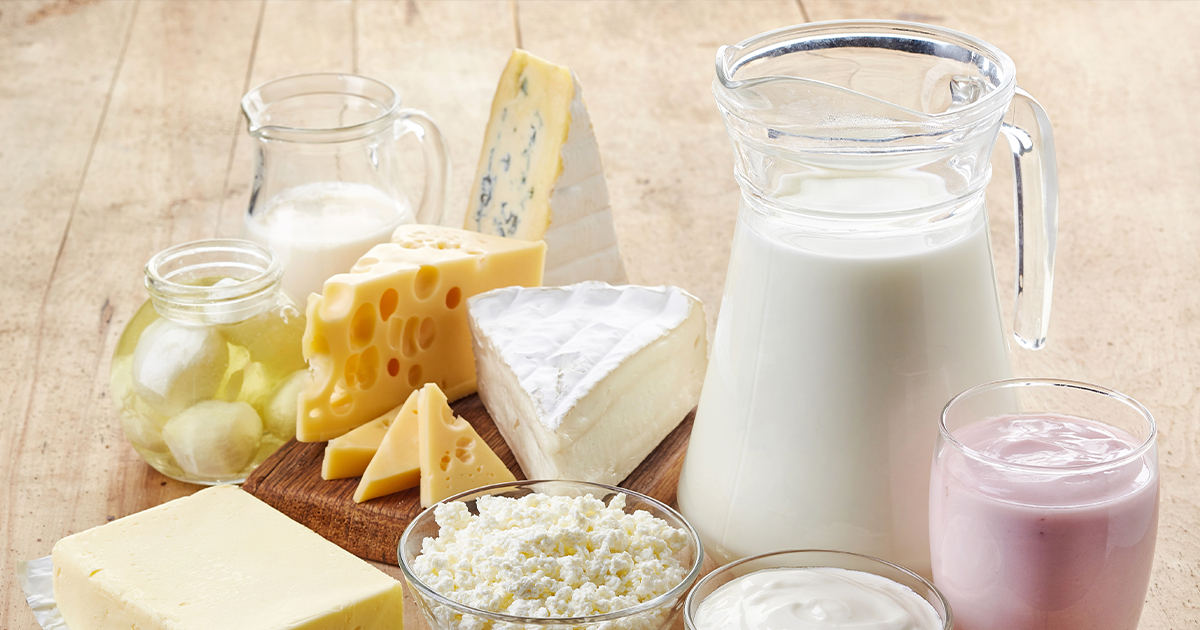By Laurie Gorton
March 2022
Educating
the industry
When Sosland Publishing added coverage of bakery technology in the late 1970s, it set the stage for today’s industry knowledge authority.


Milling & Baking News struck the spark that ignited today’s Baking & Snack magazine when it reported technical papers given at the 1977 International Bread Congress. The coverage ran in various 1978 issues. Although the magazine had reported meetings of the American Society of Bakery Engineers in the past, the Bread Congress accounts proved seminal.
Feedback quickly validated the potential for more examination of such topics. Less than a year later, Baking Equipment Quarterly debuted as a supplement in Milling & Baking News March 13, 1979.
“We got great response from readers and advertisers alike,” said Mike Gude, publisher of Baking & Snack, Milling & Baking News and Food Business News. “Today, the magazine and its digital products are the industry’s knowledge authority. That’s what the magazine’s mission has been from the start.
“Baking & Snack is the indispensable voice of the grain-based foods industry,” he added.
Mission-directed editorial
With a focus on processing and in-plant operations, Baking & Snack covers the development, production, packaging, distribution and operations management of grain-based foods manufacturing. Editorial topics include ingredients, production and packaging technologies, company/plant features, industry news and market trends. It has a circulation of 11,700 print and digital subscribers, audited by BPA, and 75,344 average monthly unique visitors to the bakingbusiness.com website.
The folio of the first issue was 32 pages; today, issues can reach 180 to 220 pages.
In 2021, the magazine reaffirmed its commitment to readers with a new editorial team led by Editor Charlotte Atchley.
“We go to our readers for information to guide and inform our coverage,” she said. “We did this to keep our magazine and digital products relevant. The suppliers to the baking industry are another major resource for our work.”
Ms. Atchley continued, “The magazine’s mission today is what we have striven to be all along: to be the authoritative voice, to support industry growth and to provide readers with ways to improve their businesses, all through publication of actionable information.”
Startup leadership, expertise
Baking Equipment Quarterly began life under the editorial supervision of Gordon Davidson, managing editor of Milling & Baking News, and Mark Sabo, director of publications for Sosland Publishing Co. Milling & Baking News associate editors — John Beal, Laurie Larson and Mary Wickersham — wrote and edited articles. Bob Kalmus supervised advertising sales as Baking Equipment Quarterly general manager, and Mr. Gude served as an advertising representative.
In late 1982, Sosland Publishing acquired Bakers Digest from E.J. Pyler and Siebel Publishing. The company decided to boost Baking Equipment Quarterly to every other month, alternating with Bakers Digest. It was renamed Baking Equipment and became a freestanding magazine a few years later.
In early 1983, Mr. Sabo brought in Laurie Gorton from a competing publisher to edit both bimonthlies. That year, editorial preparation of Baking Directory & Buyer’s Guide shifted to the Baking Equipment staff. That year as well, Josh Sosland joined his family’s company and served for several months as production editor of Baking Equipment before moving to the markets desk at Milling & Baking News; he is now president of the company and editor of its flagship, Milling & Baking News.
In 1983, too, Tom Spooner, a distinguished engineer who had just retired from the presidency of a major bakery equipment company, joined Baking Equipment as a contributing editor, adding his considerable authority to its editorial offerings. Over the years, many well-recognized industry experts graced the magazine pages with their bylines: Donna Berry, Theresa Cogswell, Jeff Dearduff, Jim Kline, Rebeca Lopez-Garcia, Leland Moss, Clyde Stauffer and Richard Stier.
Publishing responsibilities transferred to Mr. Gude a few years later, and the magazine became a monthly.
During the early 1990s, a number of leading baking companies purchased or launched snack food operations. To reflect this reader trend, the magazine changed its identity to Baking & Snack Systems, later simplifying this to Baking & Snack. About this time, Mr. Gude was promoted to publishing director for Baking & Snack. Paul Lattan, who had been hired in 1990 as a sales representative, became Baking & Snack publisher in 1997. He brought in Steve Berne as editor in 1999 and assigned Ms. Gorton new duties as executive editor. In 2010, Mr. Berne joined the Sosland sales staff as associate publisher of Baking & Snack, and Dan Malovany was hired as the magazine’s editor from a competing publication.
Renewing management
As Baking & Snack moved into the 21st century, Joanie Spencer was promoted to editor/managing editor in 2015 from managing editor of bake, a sister Sosland publication. Mr. Sabo retired in 2015 and Ms. Gorton in 2017. A year earlier, Ms. Spencer became editor, and Mr. Malovany ascended to editorial director.
All this changed in mid-2020 with the departure of Ms. Spencer, Mr. Lattan and Mr. Berne. Mr. Malovany was named interim editor to manage the transition for the remainder of 2020, while Mr. Gude was tapped for a “second term” as publisher. With the start of 2021, Ms. Atchley was promoted from senior editor to editor, and Mr. Malovany took the title of executive editor.
Asked to reflect on his return as publisher, Mr. Gude demurred.
“Actually, I never left,” he said. “While my role with Baking & Snack during the past 20 years has been mostly in the background, I continued to serve as publishing director and then publisher emeritus. I’ve been able to follow Baking & Snack’s progress and growth.
“It has become a multi-dimensional and fully integrated print-and-digital publishing platform, deeply committed to serving reader and advertiser alike,” he said.
Ms. Atchley, too, brings years of perspective to her post as editor of Baking & Snack. She joined the magazine 10 years earlier, progressing from assistant editor to associate editor and, most recently, senior editor.
“With my new responsibilities, I am looking forward to working more closely with the whole Sosland team, the other editors and other magazines,” she said, noting projects already underway to collaborate with Mr. Sosland; Eric Schroeder, managing editor of Milling & Baking News; and Keith Nunes, editor of Food Business News. “They are helping us with insight and mentoring,” she observed. We are also working to break down silos and make coverage more robust.”
Legacy of innovation
Bakers Digest, founded as Siebel Technical Review in 1926, was part of that era’s technological revolution that transformed commercial baking from an industry based on craftsmanship to one in which science and technology became increasingly important, according to E.J. Pyler, longtime editor, publisher and owner of Siebel Publishing Co.
Bakers Digest served bakery engineers and production managers by reporting baking science and technology as it developed. It described major scientific findings and innovative technologies in articles written by the scientists and inventors themselves. It often published these accounts some years ahead of commercial implementation.
Many production superintendents regarded Bakers Digest as the industry “bible,” and it became the main source for “Baking Science and Technology,” the textbook used to educate most commercial wholesale bakers and university cereal and food science students. The two-volume book is now available in its fourth edition from Sosland Publishing Co.
Although Mr. Pyler had retired by 1982 when Sosland Publishing acquired Bakers Digest, his son, Richard E. Pyler, PhD, a research chemist at a major brewing company, served as the publication’s technical editor.
The new owner continued the magazine’s every-other-month schedule for several years. Baking Equipment, however, had taken the lead as the baker’s source about equipment technologies. In the early 1990s, it brought in ingredients as an editorial subject, and the role of Bakers Digest diminished further.
The company reduced Bakers Digest’s frequency to an annual special issue, Reference Source filled with statistical data about the use of ingredients. This material was later folded into Baking & Snack’s May issue and supplemented by profiles of R&D departments at leading baking companies.

You might also enjoy:
Business intelligence and market analysis address the needs of readers throughout the food processing industry.
Sosland Publishing’s new publication offers insight into a dynamic industry.
Monthly magazine explores how, where and why supermarket innovations happen.
As the industry shifts
In its first year, Baking Equipment described itself as “the equipment and engineering magazine for baked foods manufacturers: wholesale bread and cake bakers, cookie and cracker manufacturers, frozen dough producers, snack manufacturers, pasta manufacturers, foodservice bakers.” But as the industry changed, so did the magazine.
“At first, we accepted only machinery advertising, none for ingredients,” Mr. Gude said. Within a few years, however, ingredient companies started asking for space. “I recall the sales manager of a leading ingredient company telling me, ‘Mike, our customers don’t care so much about seeing piles of white powders as they do about the shiny stuff, the machines. That’s what they like. That’s what they want to see. And we want to be there when they do.’ And, yes, he got his ads into Baking & Snack.”
Much can change in 40 years, and much of it is brought about by the periodic International Baking Industry Expositions (IBIE). By participating, the editors of Baking & Snack and Sosland Publishing Co. have learned much, gained industry insight and increased their involvement as the official media provider of this show, the most important Western Hemisphere gathering for wholesale and retail bakers.
Covering major trends
As its primary assignment, Baking & Snack reports about state-of-the-art baking technology, product formulating and the bakeries that put these to work.
Chief among industry trends is the continuing replacement of manual tasks by automated controls and technician labor. Advances in controls described in the magazine pages evolved from mainframes to factory-floor-hardened PCs, programmable controllers, networks and intelligent components and from push buttons to touch screens. Through all of it, Baking & Snack was there. The disciplines of statistical process controls, enterprise resource planning and supply chain management tie plants together to optimize corporate goals and are described frequently in the magazine.
Simultaneously, a rising tide of automation is lifting productivity for all segments of the industry. Bread and buns were the first to replace nuts-and-bolts mechanization with digitally controlled equipment. This automation trend has now altered the production of bagels, cakes, croissants, pastries, pizzas, tortillas and snacks — all reported in the pages of Baking & Snack.
Constant flux characterizes the product trends. Consumer interest in health and wellness, well underway by the early 1980s, is today’s most significant influence on new food product development. The magazine offers a steady diet of articles about this new reality. It has published numerous features about how to make baked goods and snacks that are low fat, high fiber, reduced sodium, high protein, plant based, non-GMO, vegan, organic and made with ancient and whole grains — and covered a veritable tsunami of new ingredients.
“In the past few years, product development has become front and center,” Mr. Gude said. “So, the magazine has broadened its scope in coverage and circulation. We now reach readers in the functions of R&D, new product and process development, packaging and marketing, and the management of these functions, including the c-suite. All these areas affect the equipment and vice versa.”
A related trend, also closely reported in the magazine’s pages, is the burgeoning desire among consumers to avoid chemically derived ingredients. Although popular demand pushes hard for natural ingredients, such changes are not easy. Articles about replacement of dough conditioners, especially bromate, and the use of enzymes have helped bakers address this trend.
The baking industry, like the food industry as a whole, has been profoundly reshaped by government regulations. The Clean Air Act of 1970, for example, forced changes in ovens to cut ethanol emissions, and alterations to rules governing food labels restrict on-package statements of health claims and allergen content. Voluntary standards now address the presence or absence of GMO ingredients. Food safety reform, enacted in 2011 to safeguard nearly every aspect of food plant operations, has been extensively examined in the magazine.
Another industry factor is consolidation.
“This trend has been with us for a long time,” Ms. Atchley said, “but there are still opportunities for outreach to new players.”
Indeed, many of the food processing industry’s newest businesses are in the snack food category. She cited Sosland’s Food Entrepreneur and Food Business News as sources for many editorial leads.
Data-directed editorial
“When I became editor, Dan Malovany and I had extensive conversations about the magazine’s mission but also sought ways to home in on knowledge that readers can use,” Ms. Atchley explained.
The editors and staff writers work closely with Cypress Research and BEMA Intel to base their work on relevant trends in industry data. The magazine’s annual Capital Spending Report is also shapes editorial.
“Website traffic, such as the number of clicks our stories get, is equally helpful,” Ms. Atchley said. “We closely monitor reader attention to get insight into what they want. And we are excited about what we learn from podcast traffic.
“What this means,” she continued, “is that when drawing up our editorial calendar, we are not making assumptions; instead, we are looking at real data from the readers.”
Baking & Snack remains committed to useful coverage of technology and formulating.
“But we now take these subjects to a higher level,” Ms. Atchley said, “to look at issues of processing efficiency, reduction of downtime, improvement in manpower usage and of market impact. That approach is applicable across all sectors.
“The subjects keep changing, which keeps them interesting to readers and ourselves,” she said.
Print, digital synergy
Just as Sosland Publishing was the first trade publisher to adopt computerized editing and makeup technologies, it was also a forerunner in digital products and continues to lead in this space.
“Baking & Snack and Sosland Publishing are the leaders in digital media across the entire food processing industry,” Mr. Gude said. “And there is great synergy between our digital and print efforts. It continues to expand our reach and impact on the industry, and readers can access us in the ways they want, be it digital, print or podcast.”
Baking & Snack’s first podcast, Since Sliced Bread, was launched at the beginning of 2020, and offers a new way to tell the industry’s stories.
“The podcast gives bakers and snack food makers a voice,” Ms. Atchley said. “Articles can have many sources, and you can only give them so many words in the written piece. But with the podcasts, you can dig deeper. Each guest gets 30 minutes to tell their unique stories.”
“Charlotte’s podcast, Since Sliced Bread, is extraordinarily insightful.” Mr. Gude observed.
Other digital products serve additional purposes.
“The Editor’s Pick videos have been very rewarding,” Ms. Atchley observed. “They not only promote the next issue, but they also put a face to the magazine. And we’ve done more video interviews with bakers to add a personal touch to bakery features.”
These digital offerings represent a shift in the past year to make contacts between editor and reader more personal.
“I believe this reflects a shift in society in general to make media connections more personal,” Ms. Atchley explained. “The new tools now being used — Zoom and Microsoft Teams, for example — better convey the passion that our staff has for our stories.”
Emblematic of the editorial team’s commitment to offer readers valuable and practical content, a new editorial feature, Pro Tips, was introduced in 2021.
“We recruited columnists to produce short 200-word pieces for our website,” Ms. Atchley explained.
These are prepared by contributors Rowdy Brixey and Richard Charpentier, plus Harrison Helmick, a graduate student at Purdue University, and several instructors from the AIB International.
“The function of each Pro Tip is to help us connect the readers to the magazine by addressing the challenges they face in formulating, producing and marketing,” Ms. Atchley said. “They serve a different purpose, but one still related to the mission of Baking & Snack. They will help us educate and dive deeper into technical topics.”
Sosland Publishing leads the way to IBIE
The International Baking Industry Exposition (IBIE) continues to play a key role in the development of Baking & Snack as the industry’s leading voice.
Not only do the publication’s editors participate in the company’s activities as Official Media Provider to IBIE, but they also take what they learn into the pages of the magazine.
IBIE 2001 first granted Sosland this status.
“We saw an opportunity to deepen our commitment to IBIE, and we ran with it. We were able to step into a great opportunity,” said Mike Gude, publisher of Baking & Snack, Milling & Baking News and Food Business News. “We bring our all-in attitude, subject expertise and editorial resources to promote and cover this event. It’s a unique relationship in all of trade publishing.”
Baking & Snack celebrated its 25th year in business at IBIE 2004.
Before each every-three-years show and during it, Sosland editors tell the baking industry what’s next and what to look for at IBIE.
All of Sosland’s baking-related titles participate. Baking & Snack is assigned the lead role in managing and producing the Sosland editorial projects, including the Show Daily, which is produced on-site at the show in Las Vegas.
“This event offers a good moment to step back and look at the big picture,” said Charlotte Atchley, editor of Baking & Snack. “It helps us check the pulse of the industry and our coverage of it.
“We hope that IBIE 2022 — and iba 2023 — give us back the opportunity to again meet face-to-face with bakers and key industry contacts.”
IBIE will be held in Las Vegas, Sept. 17-22.





